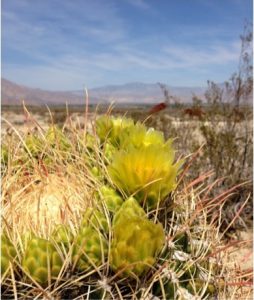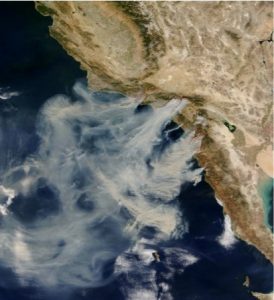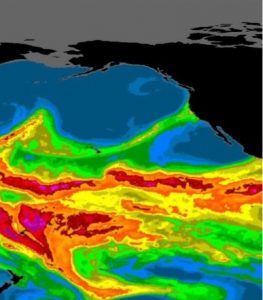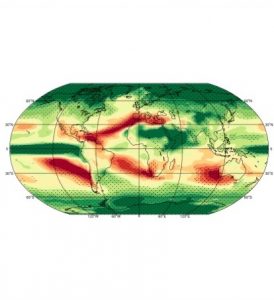
- The WECLIMA group studies relationships between regionally impactful weather extremes and large-scale climate variability and change. We also collaborate across disciplines to study impacts on public health, ecosystems, water resources, wildfire, energy, and air quality.
- Our goal is to bring large-scale climate information to human scales to improve understanding and predictability of the types of weather extremes that impact society. We mainly focus on California and the western United States, where we work with decision-makers in various sectors.
- Our current research covers a broad range of weather and interrelated climate topics including heat waves, marine layer clouds, Santa Ana and Diablo winds, wildfire, atmospheric rivers, and precipitation regimes and extremes. We are interested in both describing the past and improving short-term and long-term predictions of extreme weather events and impacts.
Heat Waves
Heat waves impact human health. With climate warming, heat waves are becoming more frequent, more intense, and longer lasting. Heat waves are also becoming more humid, with less nighttime cooling. Our group has studied heat waves of the past to improve understanding of heat wave variability and observed change. We are also analyzing heat waves from climate model projections to understand future heat wave behavior and anticipate impacts on society via human health, energy demand, and water resources. Our research topics include:
*Heat wave variability in a changing climate
*The impacts of heat waves on human health
*Coastal expressions of heat waves, including those associated with Santa Ana winds
*The impacts of heat waves on Sierra snowpack and California’s water resources
More information on Heat Waves
Marine Layer Clouds
Coastal clouds (May Gray and June Gloom, as they are known in Southern California) moderate temperatures for a huge and diverse coastal population in the summer when it can be much hotter just a few miles inland. In addition to cooling the coast, coastal species such as Torrey Pines and Redwoods rely on low clouds and fog for water and shading during the Mediterranean long dry summer. Airports alter their air traffic flow based on these clouds and the demand for as well as the supply of electricity from solar panels is strongly impacted by the presence or absence of marine layer clouds. Our group is studying cloud behavior and impacts through research topics including:
*The role of clouds in modulating heat waves in coastal California
*Past and future behavior of marine layer clouds and implications for California coastal climate
*Improving our ability to monitor cloud behavior using satellite data
*Clouds’ influence on varied ecosystems from agricultural to habitats of endangered species
High Resolution dataset of coastal low cloudiness spanning 20 years
Santa Ana Winds and Wildfire
Santa Ana winds (SAWs) are an important regional weather pattern in Southern California. They are identified as hot, dry downslope winds and are linked with the most destructive wildfires, as well as with several negative environmental health impacts such as transport of air pollutants, including smoke from backcountry fires. They are also responsible for heat waves that occur in the fall, winter and spring in coastal Southern California. We study Santa Ana winds, as well as their northern cousins (Diablos), and their impacts including:
*Natural variability of Santa Ana winds and their characteristics
*Climate change effects on Santa Ana winds and impacts
*Santa Ana winds, wildfire, smoke, and health
*Coordination between Santa Ana and Diablo winds
*Santa Ana wind-generated coastal heat waves and their health impacts
High Resolution dataset of Santa Ana winds 1948-2012
Atmospheric Rivers
Atmospheric rivers (ARs) transport moisture from the tropics to the higher latitudes. Flowing over the Pacific Ocean in long, thin ephemeral filaments, they can generate extreme precipitation over land when their moisture-laden winds encounter mountains. California’s mountain ranges are ideally (perpendicularly) oriented to landfalling ARs, which contribute the lion’s share to the region’s water supply and its variability. ARs are also the major causes of historical floods in the West. Our work on atmospheric rivers includes:
*Development of the longest available (70-year) catalog of landfalling ARs along North America’s West Coast
*Studying observed climate-scale AR behavior and it’s influence on the hydroclimate and water resources of the West
*Estimating flood damages as well as coastal water contamination resulting from ARs
*Extending the AR catalog to climate models and studying the role of ARs in the precipitation regime change projected for the North American West
*Subseasonal-to-seasonal predictability of ARs for water resource management
Catalog of landfalling ARs along the western coast of North America 1948-near present
More information on atmospheric rivers from the Center for Western Weather and Water Extremes (CW3E)
Precipitation Regime Change
Our published research shows that, while precipitation will become less frequent in Southern California as the climate continues to warm, atmospheric rivers will carry more moisture and cause more extreme precipitation. With less frequent but more extreme rainfall, year-to-year precipitation becomes more volatile. The recent years of historic drought (2012-2016) followed by record wet winter 2017 and a record-dry water year 2018, is an example of such volatility, which we expect to see more of in the future. Our research focuses on:
*Changes in the characteristics of daily precipitation and associated impacts on California’s water resources in a warming climate
*Precipitation regime change in Mediterranean climate regions around the globe
*Linkages between interannual precipitation variability, Santa Ana winds, and wildfire risk in California
Impacts on Human Health and Society
Our research aims to quantify and clarify the relationships between extreme weather events and human health, with a view towards better predictability of their impacts. We also aim to emphasize the environmental justice component of such impacts through the identification of vulnerable communities. Better predictive capacity is intended to inform and improve public health coordination and planning among stakeholders across the region. Our research topics include:
*Heat waves and health outcomes in California
*Wildfire, wind, smoke, and health
*Economic impacts of atmospheric rivers and associated floods
*Extreme precipitation impacts on California’s coastal water quality








